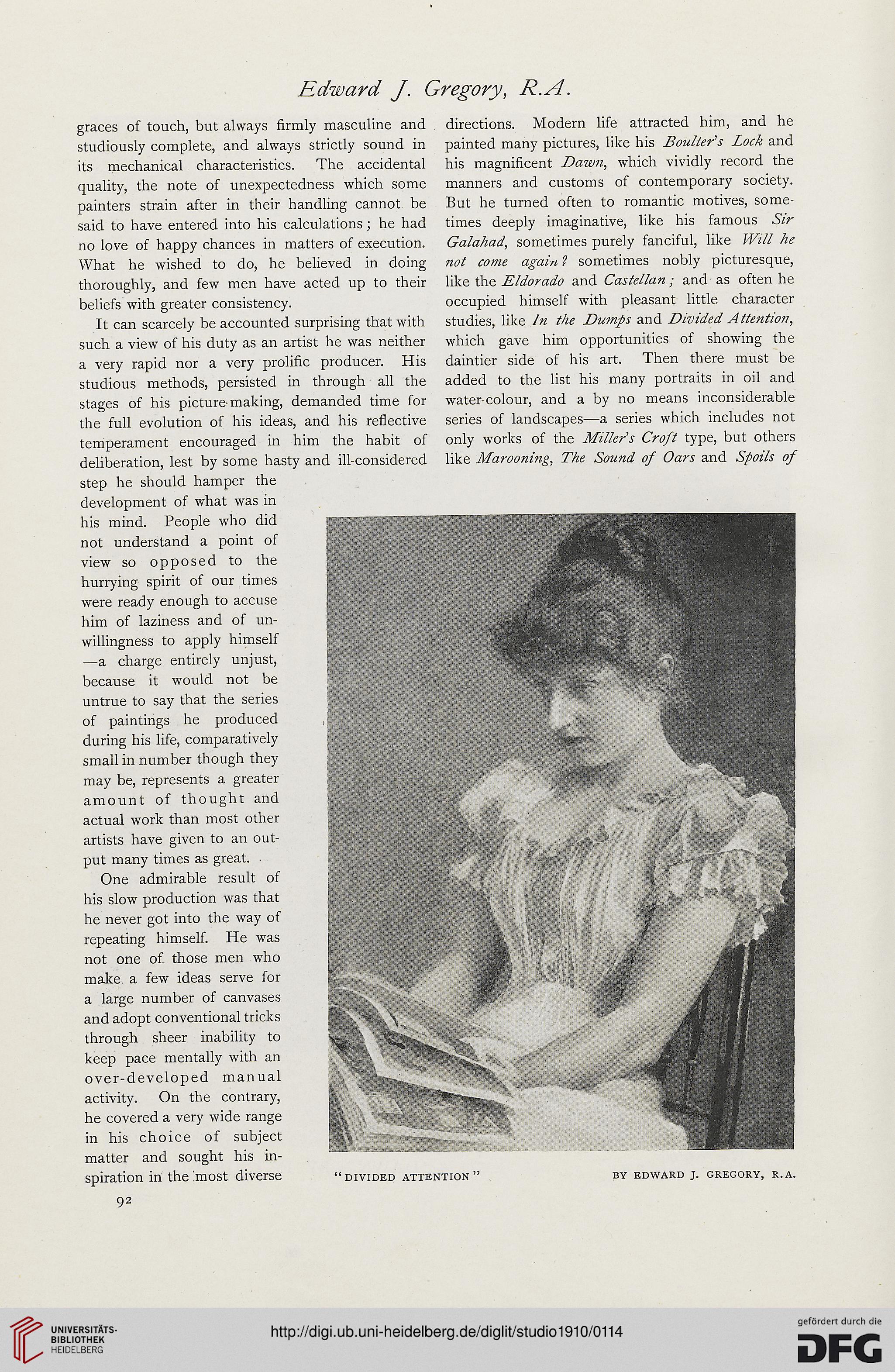Edward J. Gregory, R.A.
graces of touch, but always firmly masculine and directions. Modern life attracted him, and he
studiously complete, and always strictly sound in painted many pictures, like his Boulter's Lock and
its mechanical characteristics. The accidental his magnificent Dawn, which vividly record the
quality, the note of unexpectedness which some manners and customs of contemporary society,
painters strain after in their handling cannot be But he turned often to romantic motives, some-
said to have entered into his calculations; he had times deeply imaginative, like his famous Sir
no love of happy chances in matters of execution. Galahad, sometimes purely fanciful, like Will he
What he wished to do, he believed in doing not come again ? sometimes nobly picturesque,
thoroughly, and few men have acted up to their like the Eldorado and Castellan; and as often he
beliefs with greater consistency. occupied himself with pleasant little character
It can scarcely be accounted surprising that with studies, like In the Dumps and Divided Attention,
such a view of his duty as an artist he was neither which gave him opportunities of showing the
a very rapid nor a very prolific producer. His daintier side of his art. Then there must be
studious methods, persisted in through all the added to the list his many portraits in oil and
stages of his picture-making, demanded time for water-colour, and a by no means inconsiderable
the full evolution of his ideas, and his reflective series of landscapes—a series which includes not
temperament encouraged in him the habit of only works of the Miller's Croft type, but others
deliberation, lest by some hasty and ill-considered like Marooning, The Sound of Oars and Spoils of
step he should hamper the
development of what was in
his mind. People who did
not understand a point of
view so opposed to the
hurrying spirit of our times
were ready enough to accuse
him of laziness and of un-
willingness to apply himself
—a charge entirely unjust,
because it would not be
untrue to say that the series
of paintings he produced
during his life, comparatively
small in number though they
may be, represents a greater
amount of thought and
actual work than most other
artists have given to an out-
put many times as great.
One admirable result of
his slow production was that
he never got into the way of
repeating himself. He was
not one of those men who
make a few ideas serve for
a large number of canvases
and adopt conventional tricks
through sheer inability to
keep pace mentally with an
over-developed manual
activity. On the contrary,
he covered a very wide range
in his choice of subject
matter and sought his in-
spiration in the most diverse "divided attention" by edward j. Gregory, r.a.
92
graces of touch, but always firmly masculine and directions. Modern life attracted him, and he
studiously complete, and always strictly sound in painted many pictures, like his Boulter's Lock and
its mechanical characteristics. The accidental his magnificent Dawn, which vividly record the
quality, the note of unexpectedness which some manners and customs of contemporary society,
painters strain after in their handling cannot be But he turned often to romantic motives, some-
said to have entered into his calculations; he had times deeply imaginative, like his famous Sir
no love of happy chances in matters of execution. Galahad, sometimes purely fanciful, like Will he
What he wished to do, he believed in doing not come again ? sometimes nobly picturesque,
thoroughly, and few men have acted up to their like the Eldorado and Castellan; and as often he
beliefs with greater consistency. occupied himself with pleasant little character
It can scarcely be accounted surprising that with studies, like In the Dumps and Divided Attention,
such a view of his duty as an artist he was neither which gave him opportunities of showing the
a very rapid nor a very prolific producer. His daintier side of his art. Then there must be
studious methods, persisted in through all the added to the list his many portraits in oil and
stages of his picture-making, demanded time for water-colour, and a by no means inconsiderable
the full evolution of his ideas, and his reflective series of landscapes—a series which includes not
temperament encouraged in him the habit of only works of the Miller's Croft type, but others
deliberation, lest by some hasty and ill-considered like Marooning, The Sound of Oars and Spoils of
step he should hamper the
development of what was in
his mind. People who did
not understand a point of
view so opposed to the
hurrying spirit of our times
were ready enough to accuse
him of laziness and of un-
willingness to apply himself
—a charge entirely unjust,
because it would not be
untrue to say that the series
of paintings he produced
during his life, comparatively
small in number though they
may be, represents a greater
amount of thought and
actual work than most other
artists have given to an out-
put many times as great.
One admirable result of
his slow production was that
he never got into the way of
repeating himself. He was
not one of those men who
make a few ideas serve for
a large number of canvases
and adopt conventional tricks
through sheer inability to
keep pace mentally with an
over-developed manual
activity. On the contrary,
he covered a very wide range
in his choice of subject
matter and sought his in-
spiration in the most diverse "divided attention" by edward j. Gregory, r.a.
92




